Government-Supported Mechanic Training: Learn While You Earn and Build a High-Paying Career
The U.S. manufacturing and repair industries are constantly growing, creating a strong demand for skilled mechanics. Government-supported mechanic training programs provide individuals with the opportunity to gain valuable skills while earning an income. Whether you're a young adult entering the workforce, a mid-career professional seeking a career change, or an older worker looking for new opportunities, these programs offer a pathway to a stable and well-paying profession.

Why Choose Government-Supported Mechanic Training?
Mechanics are essential in various industries, from automotive repair to industrial equipment maintenance. According to the U.S. Bureau of Labor Statistics (BLS), the median annual salary for automotive service technicians and mechanics is $46,970, while industrial machinery mechanics earn a median wage of $59,380. Additionally, the demand for skilled mechanics is projected to grow as industries continue to expand and older workers retire.
Government-supported training programs allow students to earn while they learn, reducing financial strain. These programs also provide hands-on experience, ensuring that graduates are job-ready upon completion.
Training Opportunities for Different Age Groups
Young Adults (18-24 Years Old)
For recent high school graduates or individuals who prefer technical training over college, government-sponsored mechanic apprenticeships and community college programs offer a fast track into the workforce. Many apprenticeships start at $15-$20 per hour, allowing young workers to earn money while training under experienced professionals.
Mid-Career Adults (25-50 Years Old)
For individuals looking to switch careers, mechanic training programs provide an excellent opportunity to enter a high-demand field. Many programs offer flexible schedules, allowing participants to balance work and study. Additionally, mid-career professionals can leverage previous work experience in problem-solving and technical tasks to advance more quickly in the field.
Older Adults (50+ Years Old)
For those seeking new skills later in life, mechanic training offers an opportunity to stay active in the workforce. With flexible learning options and growing demand in industries like electric vehicle (EV) maintenance and industrial machinery repair, older workers can secure stable, well-paying jobs even without prior experience.

What You Will Learn in Mechanic Training Programs
Government-Supported mechanic training covers a wide range of technical and practical skills, including:
Basic Mechanical Knowledge – Understanding tools, components, and repair techniques.
Automotive Repair & Diagnostics – Learning to inspect, troubleshoot, and repair cars, including electric vehicles.
Industrial Equipment Maintenance – Gaining expertise in servicing factory and warehouse machinery.
CNC (Computer Numerical Control) Programming – Mastering advanced machining and manufacturing techniques.
Welding & Fabrication – Developing essential metalwork and assembly skills.
Safety Procedures & Compliance – Ensuring adherence to industry regulations and best practices.
These skills prepare students for well-paying roles in auto repair shops, manufacturing plants, and industrial service companies.
Benefits of Completing Mechanic Training
1.High-Paying Career Opportunities
Mechanics enjoy competitive wages, with experienced professionals earning $60,000-$80,000 per year. Specialized fields, such as diesel mechanics and industrial machinery repair, can offer even higher salaries.
2.Job Security & Industry Growth
The BLS predicts continued demand for mechanics, particularly as the transition to electric and hybrid vehicles increases the need for specialized technicians. Industrial equipment maintenance roles are also expected to grow, ensuring long-term job stability.
3.Career Advancement Opportunities
After completing training, mechanics can pursue further certifications to increase their earning potential. Many choose to become master technicians, supervisors, or shop owners, opening doors to entrepreneurship.

How to Apply for Government-Supported Mechanic Training
1.Find Government-Supported Training Programs
Several official resources provide information on mechanic apprenticeships and training:
Apprenticeship.gov – Lists federally recognized apprenticeship programs.
CareerOneStop – A resource for job seekers and training opportunities.
State Workforce Agencies – Many states offer subsidized training through workforce development programs.
2.Check Eligibility Requirements
Most training programs require applicants to:
Be at least 18 years old (some allow younger applicants).
Have a high school diploma or GED (not always required).
Pass a basic mechanical aptitude test (for some programs).
3.Apply and Prepare for Assessments
Some programs require skill assessments or interviews. Applicants should demonstrate problem-solving abilities, mechanical interest, and a willingness to learn.
4.Enroll and Begin Hands-On Training
Most programs include classroom instruction and paid on-the-job training, allowing participants to develop skills while earning an income.
Real-Life Success Story: David’s Career Transition
David, 37, Former Warehouse Worker
David had been working in warehouse logistics for over 15 years but wanted a higher-paying and more stable career. He discovered a government-Supported mechanic apprenticeship program through Apprenticeship.gov and decided to apply.
The program provided paid on-the-job training, allowing David to earn $18 per hour while learning. Over three years, he developed skills in automotive diagnostics, CNC machining, and welding. Upon completing the program, he secured a full-time mechanic position earning $65,000 per year with benefits.
David now plans to pursue additional certifications to specialize in electric vehicle maintenance, an industry with increasing demand.
Maximizing Your Benefits: Hidden Eligibility and Additional Perks

Many prospective mechanics may qualify for extra financial aid or tax incentives that reduce training costs:
1.Dual Eligibility for Financial Assistance
Some states offer additional grants for veterans, displaced workers, or low-income applicants.
Many apprentices qualify for Pell Grants or state workforce development Supports, reducing tuition costs.
2.Multi-State Tax Exemptions for Training Expenses
Certain states allow mechanic apprentices to deduct tool expenses, work uniforms, and educational materials from their taxes.
Relocating for an apprenticeship may qualify applicants for state-Supported relocation assistance.
3.Commercial Fleet Optimization & Employer Partnerships
Some government programs partner with automotive dealerships, trucking companies, and industrial firms to subsidize employee training costs, ensuring job placement after graduation.
Take the First Step Toward a High-Demand Career
Government-supported mechanic training provides a low-cost, high-reward opportunity for individuals seeking financial stability and career growth. Whether you're just starting out, switching careers, or looking for new skills, these programs offer hands-on training, strong job placement rates, and competitive salaries.
If you're interested in becoming a mechanic, visit Apprenticeship.gov or CareerOneStop today to find a training program near you. Start your journey toward a well-paying and rewarding career today!
